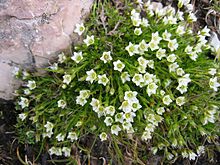Minuartia
| Minuartia | |
|---|---|

| |
| Minuartia gerardii | |
| Scientific classification | |
| Kingdom: | Plantae |
| Clade: | Tracheophytes |
| Clade: | Angiosperms |
| Clade: | Eudicots |
| Order: | Caryophyllales |
| Family: | Caryophyllaceae |
| Genus: | Minuartia L. |
| Type species | |
| Minuartia dichotoma L.
| |
| Species | |
|
See text | |
Minuartia is a genus of flowering plants commonly known as sandworts in the family Caryophyllaceae.
Minuartias are small annual or perennial plants which grow in otherwise inhospitable conditions such as on rocky ledges and in stony soil. The genus is widely distributed in the northern hemisphere, mainly distributed in Europe, in the Mediterranean region, and north Africa, southwest Asia, and the Caucasus Mountains.[1][2]
Many Minuartia species were formerly classed in the genus Arenaria, and the obsolete genus Alsine. In 2014, the polyphyletic Minuartia sensu lato was recircumscribed, with many of the species transferred to other genera, including Cherleria, Eremogone, Facchinia, Mcneillia, Minuartiella, Mononeuria, Pseudocherleria, Rhodalsine, Sabulina, and Triplateia.[1] Minuartia sensu stricto is characterized by the following features: leaves linear-setaceous; 5 acute sepals with 3, 5, or 9-veins; 5 white petals; 3 styles, forming 3-parted capsules.[1]
The genus was named for Juan Minuart (1693–1768), a Spanish botanist and pharmacist.[3]
Selected species
- Minuartia arctica – Arctic sandwort
- Minuartia austromontana – Columbian sandwort
- Minuartia biflora – mountain sandwort
- Minuartia bosniaca – Bosnian sandwort
- Minuartia californica – California sandwort
- Minuartia caroliniana – pinebarren sandwort
- Minuartia cherlerioides
- Minuartia cismontana
- Minuartia cumberlandensis – Cumberland sandwort
- Minuartia dawsonensis – rock sandwort
- Minuartia decumbens – Lassicus sandwort
- Minuartia dirphya
- Minuartia douglasii – Douglas' sandwort
- Minuartia drummondii – Drummond's sandwort
- Minuartia elegans
- Minuartia filiorum – threadbranch sandwort
- Minuartia gerardii
- Minuartia glabra – Appalachian sandwort
- Minuartia godfreyi – Godfrey's sandwort
- Minuartia graminifolia (syn. Alsine rosani)
- Minuartia groenlandica – Greenland stitchwort, mountain sandwort
- Minuartia howellii – Howell's sandwort
- Minuartia laricifolia
- Minuartia macrantha – House's sandwort
- Minuartia macrocarpa – longpod sandwort
- Minuartia marcescens – serpentine sandwort
- Minuartia michauxii – rock sandwort
- Minuartia muscorum – Dixie sandwort
- Minuartia nuttallii – Nuttall's sandwort
- Minuartia obtusiloba – twinflower sandwort
- Minuartia patula – pitcher's sandwort
- Minuartia pusilla – annual sandwort
- Minuartia recurva – recurved sandwort, sickle-leaved sandwort
- Minuartia rosei – peanut sandwort
- Minuartia rossii – Ross' sandwort
- Minuartia rubella
- Minuartia sedoides – mossy cyphel; dwarf cherleria. Confined to high mountains in Europe.
- Minuartia sintenisii – Troodos sandwort
- Minuartia smejkalii – endemic species to the central Bohemia / Czech Republic [4]
- Minuartia stolonifera
- Minuartia stricta – bog sandwort
- Minuartia tenella – slender sandwort
- Minuartia uniflora
- Minuartia verna – spring sandwort
- Minuartia viscosa
- Minuartia yukonensis – Yukon sandwort
References
- ^ a b c Dillenberger, Markus S.; Kadereit, Joachim W. (1 February 2014). "Maximum polyphyly: Multiple origins and delimitation with plesiomorphic characters require a new circumscription of (Caryophyllaceae)". Taxon. 63 (1): 64–88. doi:10.12705/631.5.
- ^ "Minuartia". Plants of the World Online. Royal Botanical Gardens Kew. Retrieved 2018-10-21.
- ^ Wilhelm, Gerould; Rericha, Laura (2017). Flora of the Chicago Region: A Floristic and Ecological Synthesis. Indiana Academy of Sciences.
- ^ http://www.sandwort.eu/cs/minuartia-smejkalii
